
The 2019 Monarch Migration Report
Updated on September 13, 2019
The Monarch migration is now surging across the Midwest and here in the Northeast, with reports of huge numbers and impressive flights this past week, particularly along the Great Lakes.
I’ve transformed this post, first published as a forecast in August, into a progress report. As it turns out, my initial forecast, certainly here in the Northeast, was spot on. We’re seeing more Monarchs in migration than we have in many years.
Examples include reports of “many thousands” passing by the north shore of Lake Ontario near Toronto on September 8, and 4,000 at the tip of Pt. Pelee National Park on Lake Erie on September 4. Here in Vermont, hawkwatchers at Mt. Philo in Charlotte reported Monarchs heading south in numbers “too many to count” on Thursday, September 12.
I’ll be out today (13 Sep) to update conditions in Vermont’s Champlain Valley. But needless to say, we’re having a banner migration across much of the Northeast. We should be seeing good numbers heading south well into October, with stragglers into November.
Nobody tracks this great autumn event better than the folks at Journey North (where you can follow the fall migration) and Monarch Watch (which runs a citizen-science tagging program). Each is a source for my own forecast here. I’ll part ways, however, with Monarch Watch, which had predicated migration in the Northeast would be on the “low side” of normal years. I predict it will be on the high side. Very high.
My evidence for this good season had been crawling on milkweed from Maine to Vermont and elsewhere online. We’ve been lousy with Monarch caterpillars here in Vermont. And up until early August, I was seeing summer Monarchs breeding to produce the migratory generation.
Assuming we have normal temperatures, reasonably healthy milkweed, and no major outbreaks of predators, parasitoids and parasites, we should see lots of Monarch adults in New England and much of the Northeast this fall. (By the way, all sorts of organisms attack Monarch eggs, caterpillars or pupae, including nematodes, mites, spiders, lacewings, wasps, fire ants, tachinid flies, hemipterans, and a panoply of microbes.)
 Yes, my evidence is anecdotal. Very much so. But my gut is strong. And it’s hard to argue with lots of people reporting online across northern New England that they’re seeing more caterpillars than ever before — or at least in a very long time. I’m among them. iNaturalist has been lit up with larvae from New England and Quebec since August 1. Those caterpillars, munching your milkweed right now, will become migrants.
Yes, my evidence is anecdotal. Very much so. But my gut is strong. And it’s hard to argue with lots of people reporting online across northern New England that they’re seeing more caterpillars than ever before — or at least in a very long time. I’m among them. iNaturalist has been lit up with larvae from New England and Quebec since August 1. Those caterpillars, munching your milkweed right now, will become migrants.
Elsewhere, Monarch Watch is predicting good prospects for a “normal” migration across much of the Monarch’s range and a “robust” winter population. In the Pacific Northwest: “After the lowest overwintering population in California ever recorded, the western monarch population is struggling to bounce back,” according to the status report, which predicts another poor year for the western wintering population. In the Southwest, they’re expecting a “low to modest fall migration,” according to the report, but the breeding was mixed across the West this year, so observers remain hopeful for Monarchs in the area this fall.
So, unless I’m wrong (and I may very well be), I’m preparing for a Monarch monsoon here in New England. Some welcome news, for a change, on a planet we’re warming and destroying by many means. And with Monarchs and so many other wild things at risk or imperiled, it’s nice now and then, even rejuvenating for us, to pause and enjoy nature before it’s gone. Let’s do that. (Heck, they even announced a cure for ebola this week!)
You can give back to Monarchs: I’ll be tagging them by the hundreds this fall. You can also report your sightings to Journey North or iNaturalist. But by all means, as I advise in my essay Butterflies and Joy, take some time to sit with these animals and witness their spectacular journey to Mexico. It might, at least for a while, make you feel good — and ever more eager to carry on the fight for nature.

Butterflies and Joy
Two hundred orange butterflies in a meadow of purple wildflowers. It reminds me to slow down, lose the gadgets and find the joy.

"To Pimp a Butterfly"
Sorry, Kendrick Lamar. You may have won a Grammy, but you got beat in the "pimping" by a lawn-care company.

Migrate or Die
The fate of late-season Monarchs in migration on the East coast. Many may not make it to Mexico.


Still flying in November, Angie?
There was a ton at the Knabusch Math and science center in Monroe Michigan.
A spectacular year, indeed! Thanks, Patrick.
Deep in the heart of …! 🙂
I’ve seen more this year in the Syracuse, NY area than I have in years.
They are in Wimberley Texas today!
More are on the way, Mel!
Great news, Dorothy. Thanks!
Thanks, Stuart. I’m not as keyed in to the Midwestern migration. But it’s still going fairly strong, I assume. One good place to track it is JourneyNorth: https://journeynorth.org/monarchs
You’re in the thick of it now, Linda! Enjoy!
Wonderful! I was hoping to be able to see the Monarchs, in/around the Metroplex, when I get back to Fort Worth, from Chicago (I’ve only seen one, since I got here, toward the end of Sept and I’ll be back, on Oct 13).
Saw my first “wild” monarch today (Oct 8, 2019) in Bedford, Texas. I assume this is an early bird.
Based on reports we should start seeing more each day.
My butterfly garden and I have been waiting and watching for them.
Mr. Pfeiffer, I live in Kansas, Eastern Kansas and yesterday Sunday, October 6th, 2019, I witnessed a great many monarchs flying south. Lepidoptera, are some of my long time friends. The migration, if that a what it was, was gorgeous. I am a retired science teacher ( biology, anatomy & physiology), these critters are spectacular. Does this time frame for migration fit? It has been quite cool here, and yesterday was in the mid-50’s and overcast, with rain showers through out the day. I would be happy to add more info if you require?
Just counted over 50 flying over my house here in Lenoir, NC in the foothills of the Blue Ridge area. Amazing sight!
Our meadow in Chester, Vermont, is loaded with milkweed, and everywhere I look I see instar 4 and 5 caterpillars munching away and monarch butterflies fluttering and soaring! Am raising 26 outdoors -because of the new information out on a decreased instnct for migration in those raised indoors. Have also learned to tag and release both reared and wild-caught monarchs to help MonarchWatch.org. Just waiting for more tags to arrive now. Like you, I think it is a bumper crop this year. Watching and nurturing these amazing creatures is a welcome respite from the daily news.
Thanks for the report, Kay. I suspect you’ll be seeing a steady “flow” of Monarchs for at least a month. Hope so!
Hi Colleen,
As it turns out, I dreamed about emerging Monarchs last night. (And I do indeed dream in color.) 🙂
I was lucky enough to watch an an emerging Monarch from one of by (known) chrysalis. I did get some video ans still photos, but it’s a long
process. What a thrill!!
My milkweed crop quadrupled this year in a wildflower meadow intended to attract birds and butterflies in Hinesburg VT. After 4 years, from 8 plants we’ve now hundreds. Some along driveway, where I saw caterpillers. Most plants are deeper in the meadow but I could see the flowers over summer. Now, I’ve been seeing many monarchs around the property. Hope many make it. Really glad to hear your prediction.
Hi Meredith, I suspect you’ll be seeing migrants from here in the north coming through soon. They tend to begin showing up at your latitude in late August, with peak migration somewhere from 19 September – 1 October or so.
Wow — that is impressive, Patti! I’m not sure how you can keep up with it! 🙂
WOW! I’m finding that’s it’s a bit slow in MD. While traveling thru New England recently I found the Monarch population to be much more prevalent. Anyone have any insight on this?
This has been an amazing year! So far I have released 405 Monarchs with hundreds to go. I found almost 900 eggs just in my milkweed garden beds in my yard. I hope next year is just as rewarding. I am in Northern IL.
… and what’s your location, Carol??? 🙂
You must be busy, Debra! Glad you’re doing your part! 🙂
I have lots of caterpillars this year! five found chrysalises with one hatching today!! Never have seen so many! Excited!
I live in East Central Indiana. My sister and I have been encouraging Monarchs this year with a butterfly garden, full of various milkweeds and butterfly attracting plants. So far we have raised and released over 20 Monarch butterflies. We bring them inside and feed them because our lovely bird population seems to enjoy their taste. We have 28 new caterpillars to take care of. We are trying to do our part to keep the Monarch butterflies alive and well.
Well, you never know — I have family in Southeastern Michigan. 🙂 So I’ll check out Downriver Butterflies. Thanks, Linda!
Hi Rita,
This sounds great. I really like it when we all challenge our notions of doing well for nature. Sometimes, despite our best intentions, we are unwitting not doing the best for nature. But I agree with you that education, example and exuberance are currency in conservation. Especially with kids. They need to see us adults having fun out there and intimate with nature. It sounds as if you’re doing just that. Thanks!
Hi Carol,
It’s hard to say, in many cases, if any given Monarchs make it to Mexico. But why not? They’re on time for the migration. We never know. But I don’t see any reasons why they shouldn’t
I live is St.Clair County, southeast Michigan. So far this year, I have released 29 Monarch’s, have 14 Crysalis hanging, 8 Cat’s and 6 itty bitty Cat’s that hatched from eggs. My husband, boys, family and friends all thought I was a little nuts last year, when I first took interest. Untill they saw my Joy and Love of watching these beautiful creatures evolve. My goal this year was to release 21 Monarch’s, I am ecstatic with reaching my goal and have now raised my goal to 75!
Here in Southeastn Michigan there are so many people raising Monarchs, myself included. There a some that have released hundreds already. I belong to a FB group called Downriver Butterflies. Karen Wallace Hoffman is our local expert. You should visit.
I’m in Middleton, Wisconsin. Started “home raising” monarchs last year. I have read many articles this year about whether or not this is a good idea. I like to believe that I am helping the monarch population. The best way for me to do so, however, is to educate others on the importance of growing milkweed, not using pesticides, and, planting butterfly and bee friendly flowers.
This morning after church, I took my butterfly tent, posters, books, and kid monarch wings and antenna, and we walked through the prairie to look at eggs, butterflies, and insects through magnifying glasses. What a joy nature is!
Wow. Encinitas, CA? You’re not far from those over-wintering western Monarchs! 🙂
Thanks for the Midwestern report, Valerie. Oh, yeah — I’ll bet you’ll be finding more chrysalises soon!
Yet more big numbers from Maine. I’m looking forward to getting back there with tags. Thanks, Nan!
Thanks, Robyn. That’s an interesting account. Normally, adults don’t walk much before flight.
Hi Bryan…im in Southern NJ abt 8 cats in several stages in containers. Will they make it to Mexico?
Carol
Wow — 60! If you read some of the new Monarch Watch tagging guidelines, they’re trying to distinguish reared vs. wild Monarch success rates to Mexico. As I recall, reared Monarchs tend to be a bit smaller. Thanks, Chris!
You mean just one Monarch, Pamela?
Raising Monarchs 3 years in a row!!
Brought them indoors this year from egg to butterfly ..keeping the fly larva away!!
Success in Encinitas!!
I live in northern western part of Michigan. I won’t let anyone cut down my milkweed plants. Mine are wild. I have them all over our property. There are tons of plants. And I have never seen so many caterpillars, ever in my life. I’m 61 years old. I have found 1 crystalis. But as many caterpillars as I’ve seen, ill keep looking. I’m so excited. I love all nature.
We live on North Haven Island off the coast of Maine. We have seen many ,many more monarchs (and other butterflies,too) than we have seen in the last few years. Last year, almost noon; this year SOO many. They love the Linden tree’s blossoms.
Here in the Northeast Kingdom, I planted milkweed 4 years ago for Monarch habitat. We had our first Monarch last year. With amazing luck and timing I witnessed a brand new Monarch crawling across the yard from the North side of the house (where we visited the chrysalis daily) to the South side of the house where it found a coneflower in the garden, climbed up to the top, and finished drying and spreading its wings. The slow march and climb took an hour and a half. This year we have lots of caterpillars.
You met my daughter Andrea at a photography class. She and her family brought a huge container of monarchs from her fenced-in garden area so that she could take care of them while in Vermont this week. There are more than 60 chrysalises and they have eaten lots of milkweed from North Hero. She has done this for about ten years but never had more than one-tenth that amount before. I agree with your prediction.
we live in the Northern portion of Illinois close to the Wisconsin border. Last year we had a monarch straggler that made it an approximately October 15th. are milkweed bush is full of orange buds and we’re hoping for another monarch this year.
I’ll check this out. Thanks, Meena. (It showed up late in comments because it got held for moderation, owing to the link include; I just now noticed it.)
Thanks, Mary-Ellen. At some point, I’ll write about mowing and Monarchs (and other wildlife). I think we can do so much for wildlife if we just mowed less and kept more gardens, as you’re describing. 🙂
Thanks, Meredith. Yes, I’m getting other reports like this from Maine. We’ll be busy here in New England this fall!
Wow, do the anoles eat the caterpillars, Cathy???
Thanks for the report, Craig. Monarchs are all over Monhegan as well. So Maine should be busy with orange and black very soon!
Yeah, it’s hard NOT to find Monarch caterpillars right now. 🙂 Thanks, Judy!
Thanks, Susan. And so much great stuff in our own backyards!
Hi Peter, It really comes down to Monarchs finding milkweed from June into August. As adults they also seek out nectar sources, even if the milkweed isn’t flowering. So any good butterfly nectar for them nearby would help. But, to be honest, it can be hit or miss. Now, with milkweed mature, and getting a bit late in the season, most Monarchs are done mating and laying eggs. So there’s not much you can do to get caterpillars on that milkweed this year. Another option is to cut it back early in the season next year — like in June. When it regrows later in the season, Monarchs showing up seem to like the younger, more tender milkweed leaves that follow. You might find more information on this at Monarch Watch. Keep me posted!
A long road toward recovery, Veer. Thanks!
Hi Jenny,
Well, they do tend to follow shorelines some — and some predictable routes, even though all Monarchs are making the trip toward Mexico for the first time, and will make it only once. Any nectar sources along the way help. Monarch Watch has (I think) a program of “waystations” to encourage folks to plant nectar sources for Monarchs. But, you’re right — we mow way too much as a society. In most cases, less mowing is much better for wildlife.
Thanks for the report, Roger. Good data! 🙂
Right on, Bernie.
I live in the Tampa Bay area and I usually get them late fall to early spring. I have been cultivating my milkweed for when they return. I have 4 habitats as the anoles and wasps kill the caterpillars. It is such a joy seeing them turn into butterflies!
Agreed with your assessment, Bryan. Near Damariscotta ME – 42 chrysalis (chrisali?) on one small clump of milkweed. Larger presence than normal patterns!
Thanks for your reflections and earth-centered care.
Craig
Milkweed plants at The Wild Center in Tupper Lake in the Adirondacks are lousy with monarch caterpillars of all sizes. What a joy!
I agree. We need to connect with nature in order to see the need to protect it. Thank you.
I have about 20 healthy milkweed plants in a cluster next to our driveway (in the Upper Valley of Vermont). They have a large number of pods. Yet they’re not attracting any caterpillars. Any thoughts on why they’re not and what I can do?
Fingers, toes, hearts, souls all crossed for the Monarch journey and recovery! : )
We saw a large group of migrating monarchs several years ago. It was the end of August, at the top of the Bolton ski slope with the fire tower platform behind it. Will need to check that area out again.
Do monarchs migrate along the same corridor each year?
Also I’ve noticed power lines, ski slopes, and solar fields can be loaded with wildflowers, grasses (and some invasives) but are often mowed too early in the summer for birds, butterflies and other pollinators. That could add up to a lot of useful habitats if they could be managed and mowed just a couple of weeks later.
Here in Mid-coast Maine I am seeing more monarchs than any other year since I moved here 8 years ago. In the last couple of days, we’ve also had a modest influx of Painted Ladies, so our nectar plants are ablaze with orange and black.
Great article! I am a U of MD Baltimore Co Master Gardener and I have been raising Monarchs for the past three years. This past week I was traveling home from NH with 8 boxes of Monarchs in various stages. Driving thru the upper-mid coast of Maine I was desperate for milkweed leaves to feed my brood! I came across a long section of milkweed along a country road and was ecstatic to see Monarch caterpillars dripping from the milkweed plants! I have never seen such an abundance of cats anywhere before! How wonderfully encouraging!!
Thank you Bryan for this information on monarch migration I have noticed other butterflies this summer in and around my flower beds and gardens. I hope that we all begin to pay more attention to these lovely and colorful flying creatures and help to support organic agricultural practices that will help them.
In Entomology Today, there is an interesting article about insect conversations. Your readers might be interested.
https://entomologytoday.org/2019/08/16/look-science-insect-conservation/
Lucky for us Mexico lets them in. And lucky the little guys and gals have enough energy once they get to the border, to cross any final man-made impediments that may be there.
Buen viaje lovely creatures.
Seeking to live a life of greater simplicity closer to nature.
~Bernie Paquette